1861–1862 Fox Ministry
The Second Fox Ministry was a responsible government which held power in New Zealand from July 1861 to August 1862. Although William Fox was the head of the government, he was never appointed Premier as that office had yet to be established. Instead, he was Attorney-General and then Colonial Secretary.[1]
Background
The Second Fox Ministry took power after winning a motion of no confidence against Edward Stafford by two votes amid rising tensions with the Kingitanga movement.[2] The new government survived another no-confidence motion a month later, surviving by reconstructing the Cabinet with the absence of Isaac Featherston and John Williamson – it had been argued by the Opposition that they were ineligible for office in the central government as they were both Provincial Superintendents.[3] Even without the Superintendents, Fox's ministry was highly provincialist in policy, amending the New Provinces Act to prevent existing provinces from splintering into non-viable local entities.[2]
The major crisis of New Zealand politics in the 1860s was the Māori question, with Fox leading the 'Peace Party' which was purported to prefer a non-violent resolution to the dispute with the Waikato iwi.[4] This would involve incorporating Māori into Pākeha-style constitutional institutions such as local councils or Rūnanga.[4] Previously, Māori policy had been reserved to the Governor, but now Governor Grey convinced the ministry to take on responsibility for this aspect of national politics.[5] To Fox's surprise, the British government responded by giving notice that the New Zealand colonial government would have to fund their own military defences against Māori, while the Imperial troops would be withdrawn.[2]
This ultimatum had the impact of weakening the authority of the Fox Ministry, and Stafford was able to defeat the government in a no-confidence vote a year after Fox had taken office, although only by means of the Speaker's casting vote. Stafford declined to form a new government and Grey appointed Alfred Domett instead.[6]
Ministers
The following members served in the Fox Ministry:[7]
| Name | Portrait | Office | Term |
|---|---|---|---|
| William Fox | 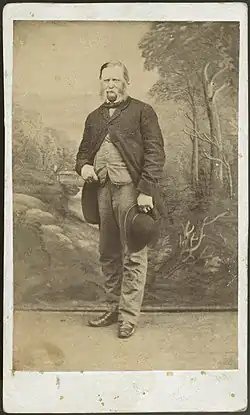 |
Attorney-General | 12 July 1861 – 2 August 1861 |
| Colonial Secretary | 2 August 1861 – 6 August 1862 | ||
| Isaac Featherston | 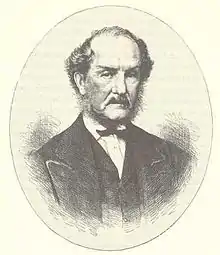 |
Colonial Secretary | 12 July 1861 – 2 August 1861 |
| Reader Wood | 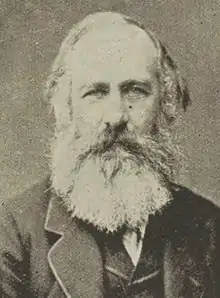 |
Colonial Treasurer | 12 July 1861 – 6 August 1862 |
| Commissioner of Customs | 12 July 1861 – 6 August 1862 | ||
| Walter Mantell |  |
Minister of Native Affairs | 12 July 1861 – 18 December 1861 |
| John Williamson | %252C_1860.jpg.webp) |
Member of Executive Council | 12 July 1861 – 2 August 1861 |
| Thomas Henderson | .jpg.webp) |
Member of Executive Council | 12 July 1861 – 6 August 1862 |
| Daniel Pollen, MLC |  |
Member of Executive Council | 20 July 1861 – 6 August 1862 |
| Henry Sewell, MLC | 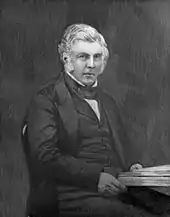 |
Attorney-General | 2 August 1861 – 6 August 1862 |
| Crosbie Ward | 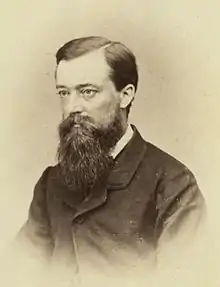 |
Postmaster-General | 2 August 1861 – 6 August 1862 |
| Secretary for Crown Lands | 2 August 1861 – 6 August 1862 | ||
| Lt.-Gen. Duncan Cameron | 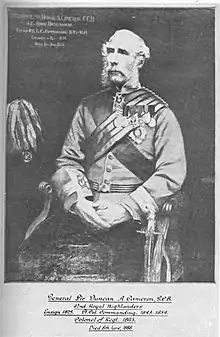 |
Member of Executive Council | 22 April 1861 – 6 August 1862 |
See also
Notes
- Wilson, J. O. (James Oakley) (1985). New Zealand parliamentary record, 1840–1984 (4th ed.). Wellington: Government Printer. p. 61.
- McLintock, Alexander Hare; William Parker Morrell, M. A. (N Z. ); Taonga, New Zealand Ministry for Culture and Heritage Te Manatu. "FOX, Sir William". An encyclopaedia of New Zealand, edited by A. H. McLintock, 1966. Retrieved 4 November 2022.
- Bohan, Edmund (1994). Edward Stafford: New Zealand's First Statesman. Hazard Press. p. 166.
- Taonga, New Zealand Ministry for Culture and Heritage Te Manatu. "Sewell, Henry". teara.govt.nz. Retrieved 4 November 2022.
- Bohan, Edmund (1994). Edward Stafford: New Zealand's First Statesman. Hazard Press. p. 173.
- Bohan, Edmund (1994). Edward Stafford: New Zealand's First Statesman. Hazard Press. pp. 175–6.
- Wilson, J. O. (1985). Parliamentary Record of New Zealand (4th ed.). Wellington: Government Printer. p. 61.